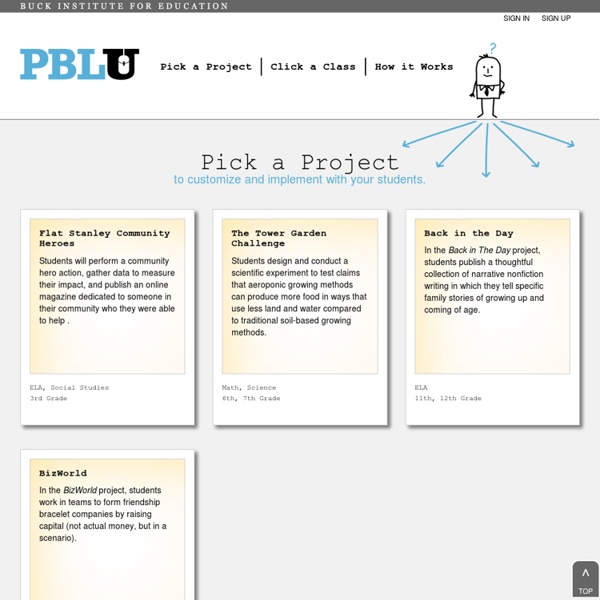for Teachers
Instructables supports teachers and students by providing free Premium Memberships and awesome project ideas for your classroom. For Students A premium membership means access to all of our classes. Learn everything that Instructables has to offer with classes ranging from electronics to pasta making to leatherworking. If you've got a great project to share, we're constantly running contests to reward the best instructables.
Project-Based Learning vs. Problem-Based Learning vs. X-BL
At the Buck Institute for Education (BIE), we've been keeping a list of the many types of "_____- based learning" we've run across over the years: Case-based learning Challenge-based learning Community-based learning Design-based learning Game-based learning Inquiry-based learning Land-based learning Passion-based learning Place-based learning Problem-based learning Proficiency-based learning Service-based learning Studio-based learning Team-based learning Work-based learning . . . and our new fave . . . Zombie-based learning (look it up!) Let's Try to Sort This Out The term "project learning" derives from the work of John Dewey and dates back to William Kilpatrick, who first used the term in 1918.
The Differentiator
Try Respondo! → ← Back to Byrdseed.com The Differentiator The Differentiator is based on Bloom's Taxonomy, Kaplan and Gould's Depth and Complexity, and David Chung's product menu. Try It In: French Dutch • Tweet It • Like Byrdseed • Pin It
"A Problem Based Learning Meta Analysis: Differences Across Problem Ty" by Andrew Walker and Heather Leary
Abstract Problem based learning (PBL) in its most current form originated in Medical Education but has since been used in a variety of disciplines (Savery & Duffy, 1995) at a variety of educational levels (Savery, 2006). Although recent meta analyses have been conducted (Dochy, Segers, Van den Bossche, & Gijbels, 2003; Gijbels, Dochy, Van den Bossche, & Segers, 2005) that attempted to go beyond medical education, they found only one study in economics and were unable to explain large portions of the variance across results. This work builds upon their efforts as a meta-analysis that crosses disciplines as well as categorizes the types of problems used (Jonassen, 2000), the PBL approach employed (Barrows, 1986), and the level of assessment (Gijbels et al., 2005; Sugrue, 1993, 1995). Across 82 studies and 201 outcomes the findings favor PBL (d = 0.13, +/- .025) with a lack of homogeneity (Q = 954.27) that warrants a closer examination of moderating factors.
Five Keys to Rigorous Project-Based Learning
Voiceover: How will today’s children function in a dangerous world? What means will they use to carve the future? Will they be equipped to find the answers to tomorrow’s problems? Teacher: When you think about traditional learning you think of a student sitting in a classroom and being talked at.
Gold Standard PBL: Essential Project Design Elements
Adapted from Setting the Standard for Project Based Learning: A Proven Approach to Rigorous Classroom Instruction, by John Larmer, John Mergendoller, Suzie Boss (ASCD 2015). This post is also available as a downloadable article. It’s encouraging that Project Based Learning is becoming popular, but popularity can bring problems. Here at the Buck Institute for Education, we’re concerned that the recent upsurge of interest in PBL will lead to wide variation in the quality of project design and classroom implementation. If done well, PBL yields great results.
PBL Gallery
Home | Getting Started | Modules | Resources | About Us View the work of teachers who developed and implemented PBL units/mini-units. Feel free to download and use the PBL as a template for your work with students. We appreciate your feedback. View additional middle school projects on the STEM-MI Champions Gallery page.
What is PBL?
To help teachers do PBL well, we created a comprehensive, research-based model for PBL — a "gold standard" to help teachers, schools, and organizations to measure, calibrate, and improve their practice. In Gold Standard PBL, projects are focused on student learning goals and include Essential Project Design Elements:



This is a great resource on how to implement project based learning into your class, taking into consideration your student dynamics. This tool is great for helping teachers select projects that are best suited to their particular learning situation as there isn't a one-project-fits-all. Taking the time to go through the process could make the difference between having a not so successful project and an outstanding memorable learning experience. by chedwards Oct 12